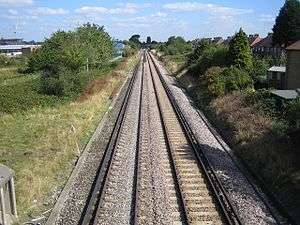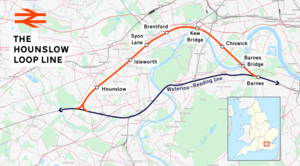Hounslow Loop Line
The Hounslow Loop Line is a railway line in southwest London which was opened by the London and South Western Railway in 1850. It leaves the Waterloo to Reading Line at Barnes Junction and after some seven and a half miles rejoins it at a triangular junction between Whitton and Feltham. Passenger services, all operated by South Western Railway, either loop back to Waterloo by the junctions or continue southwest via Feltham. The line is electrified at 750 V DC (third rail). It provides access to the North London Line for freight services both passing through Clapham Junction to the north east and connecting to the rail network to the south west.
| Hounslow Loop Line | |||
|---|---|---|---|
 The line between Hounslow and Isleworth | |||
| Overview | |||
| Type | Commuter rail, Suburban rail | ||
| System | National Rail | ||
| Status | Operational | ||
| Locale | Greater London | ||
| Termini | London Waterloo | ||
| Stations | 7 | ||
| Operation | |||
| Opened | 1850 | ||
| Owner | Network Rail | ||
| Operator(s) | South Western Railway | ||
| Rolling stock | |||
| Technical | |||
| Number of tracks | 2 | ||
| Track gauge | 1,435 mm (4 ft 8 1⁄2 in) standard gauge | ||
| Electrification | 750 V DC third rail | ||
| |||
Hounslow Loop Line | ||||||||||||||||||||||||||||||||||||||||||||||||||||||||||||||||||||||||||||||||||||||||||||||||||||||||||||||||||||||||||||||||||||||||||||||||||||||||||||||||||||||||||||||||||||||||||||||||||||||||||||||||
|---|---|---|---|---|---|---|---|---|---|---|---|---|---|---|---|---|---|---|---|---|---|---|---|---|---|---|---|---|---|---|---|---|---|---|---|---|---|---|---|---|---|---|---|---|---|---|---|---|---|---|---|---|---|---|---|---|---|---|---|---|---|---|---|---|---|---|---|---|---|---|---|---|---|---|---|---|---|---|---|---|---|---|---|---|---|---|---|---|---|---|---|---|---|---|---|---|---|---|---|---|---|---|---|---|---|---|---|---|---|---|---|---|---|---|---|---|---|---|---|---|---|---|---|---|---|---|---|---|---|---|---|---|---|---|---|---|---|---|---|---|---|---|---|---|---|---|---|---|---|---|---|---|---|---|---|---|---|---|---|---|---|---|---|---|---|---|---|---|---|---|---|---|---|---|---|---|---|---|---|---|---|---|---|---|---|---|---|---|---|---|---|---|---|---|---|---|---|---|---|---|---|---|---|---|---|---|---|---|
| ||||||||||||||||||||||||||||||||||||||||||||||||||||||||||||||||||||||||||||||||||||||||||||||||||||||||||||||||||||||||||||||||||||||||||||||||||||||||||||||||||||||||||||||||||||||||||||||||||||||||||||||||
Passenger services and rolling stock
The typical weekday service in trains per hour is:
- 2 from Waterloo, taking the loop at Barnes and leaving it beyond Hounslow to go via Richmond to return to Waterloo
- 2 from Waterloo, running via Richmond and taking the loop at Hounslow and returning to Waterloo
- 2 from Waterloo, taking the loop at Barnes and leaving it beyond Hounslow to go via Feltham to Weybridge
- 2 from Weybridge, taking the loop at Hounslow and returning to Waterloo
Limited trains to/from London start/terminate at Hounslow, however South Western Railway timetables and departure boards indicate that every other train from Waterloo terminates or starts at Hounslow whilst they are actually running as loop services.
The Sunday service is
- 1 train per hour in each direction between Waterloo and Woking via Staines
- 1 train per hour between Waterloo and Hounslow via Brentford in the afternoon.
Services are generally operated by Class 707s, operating in 5 or 10-car configuration. These trains entered service in August 2017.[1] Class 450, Class 455 and Class 458 units also work the line. All units on the line are to be replaced by Class 701 Aventra units, with introduction planned for 2020.[2][3]
Ridership
The line has seen a steep increase in ridership levels in recent years, corresponding with the doubling of train frequencies from 2 trains per hour in each direction to 4 (except on Sundays). The line's seven stations had combined passenger numbers of 5.565 million in 2007–08 (based on station exits), a 162% increase on the 2004–05 figure of 2.122 million.[4]
Recent changes
Most stations had platforms lengthened to allow the operation of 10 coach trains from May 2013.[5] Where this was not possible, selective door opening is used.
Platform 20 at Waterloo (within the former Waterloo International terminal) came into use in May 2014 to provide additional capacity.[6][7]
Future developments
A proposal published in 2017 by the London Assembly and Transport for London envisages extending the London Overground network to run trains on the section of the Hounslow Loop Line between Brentford and Hounslow.[8] The scheme, known as the West London Orbital, would involve the re-opening of the Dudding Hill Line to passenger services and running trains from West Hampstead Thameslink and Hendon via the planned Old Oak Common Lane station. A new station may be constructed at Lionel Road, close to Kew Bridge. The plans are currently at public consultation stage with TfL.[9]
References
- "Class 707s enter service on Windsor routes". Global Rail News. 18 August 2017. Archived from the original on 2 September 2017. Retrieved 8 April 2019.
- Armitage, Jim (14 February 2018). "Business focus: Why your box-fresh train is being replaced". Evening Standard. Retrieved 8 April 2019.
- Johnson, Marc (11 September 2017). "Waterloo dawn for South Western Railway". Rail Staff. Retrieved 8 April 2019.
- "Station usage estimates". Rail statistics. Office of Rail Regulation. Please note: Some methodology may vary year on year.
- Longhurst, Chris (3 September 2014). "Hounslow Loop set for more trains and longer carriages by 2017". getwestlondon. Retrieved 8 April 2019.
- "New platform and 60 extra carriages for Waterloo commuters". Department for Transport. gov.uk. 23 December 2011. Archived from the original on 5 November 2012.
- "Platform 20 at Waterloo finally opens (with five more to come)". urban75 forums. Retrieved 8 April 2019.
- "Mayor's Transport Strategy 2018". London City Hall. 5 January 2015. Archived from the original on 26 July 2019. Retrieved 26 July 2019.
- "West London Orbital". Transport for London. Archived from the original on 25 July 2019. Retrieved 30 July 2019.

